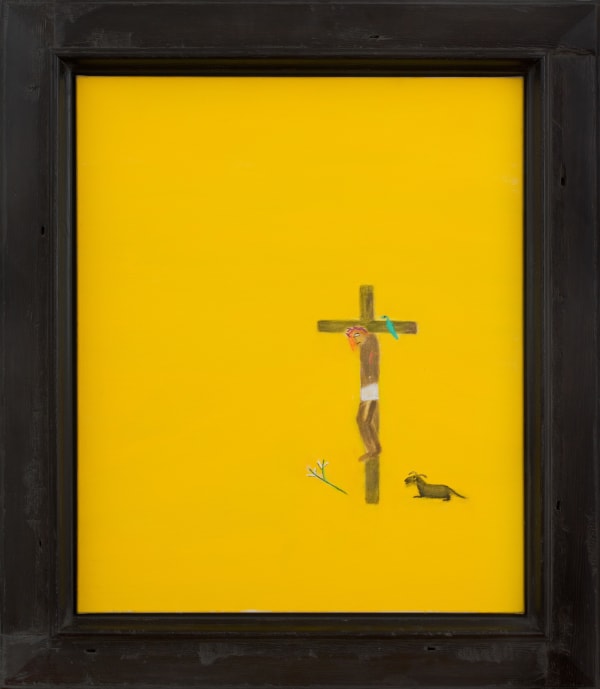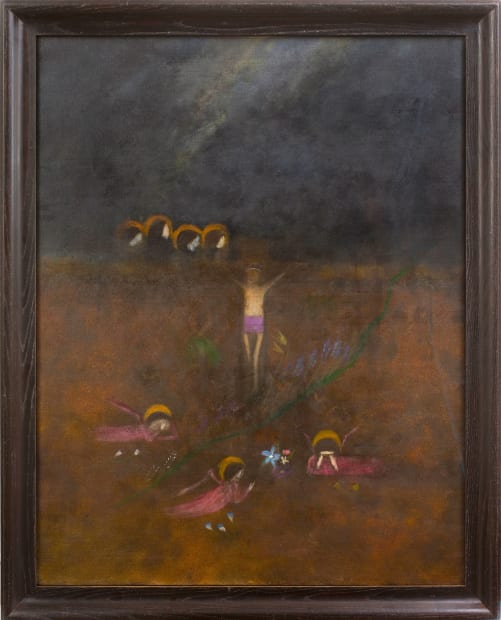-
CRAIGIE AITCHISON
—
Portraits & Crucifixions
-
Craigie Aitchison (1926 - 2009) was one of the most original British artists of his generation, his success underpinned by rigorous observation and a painter’s sensitivity to surface texture. The use of saturated mineral colouring in his work betrays a mixture of vision, a view of life beyond appearances, and craftsman-like skill, forging an intoxicating alchemy of yellow and cerulean, umber and viridian. In Aitchison’s paintings the apparent simplicity of the work conceals many difficult, carefully calculated creative acts.
The use of vivid colour in Aitchison’s work is intentionally guileless, free of pretext and without any codified meaning. In his thinking about art, there was a close relationship between what he called ‘posh paint’ – the use of thick paint and textured brushwork – and pretentiousness. He was vehemently, sometimes angrily critical of pretentious art and he regularly chastised those artists he thought guilty of using ‘posh paint’, such as Francis Bacon or Howard Hodgkin. This dislike of pretension was complemented in Aitchison’s work by self-conscious allusions to ‘low’ culture, the use of gaudy colouring, (as in the below Portrait of Simon de Wrongal), and the unerring thinness of his paint – a rejection of the self-indulgent virtuosity which he perceived in some of his contemporaries.
-
-
To Aitchison, the crucifixion was a spiritual event rather than a textual one. In his imagination, it played out in a mystical landscape that shimmered between decorative flatness and expansive recessions of depth. When asked if he was religious, he replied: ‘I don’t know what it means. I think if you think you’re religious, it’s a bit conceited.’ His grandfather was a Presbyterian minister, nevertheless, and his parents took him to both Protestant and Roman Catholic church services as a child. His attitude to religion was complicated further by a scholarship in Italy that Aitchison took in 1955. He was profoundly affected by the fervent cult of devotional imagery and statuary which he found there, as well as religious paintings by the likes of Giotto, Fra Angelico and Masaccio.
Aitchison latterly developed his own collection of religious icons, predominated by small kitsch figurines of St Francis of Assisi, the Virgin and Child and, most numerous of all, Christ on the cross. These images filled his home in Kennington, creating a joyously cluttered atmosphere and providing him with the models for paintings. Though he never studied the detail of these icons, they provided him with a starting place – a composition or a mood without which he could not begin work. Aitchison’s figure of Christ is often depicted without arms, a trope that the artist introduced shortly after his earliest Crucifixion. He once explained: ‘everybody knows who he is. He doesn’t need arms.’ Aitchison was evidently uninterested by the confines of conventional Christian iconography, preferring to give the crucifixion a numinous poetic meaning of his own, enhanced by resounding planes of saturated colour.
-
-
Aitchison once said, ‘The Crucifixion is the most horrific story I’ve ever heard, they were all ganging up against one person. As long as the world exists one should attempt to record that.’ Later in life, Aitchison would tell a story about how a teacher at the Slade, William Townsend, had discouraged him from painting the crucifixion. Townsend rudely suggested that it was too serious for him. This unfair treatment spurred him to defy his critics and make his first paintings of the subject. Aitchison’s sense of justice is the common theme between these two stories, tying together Gospel truth with his experience of being belittled at the Slade. Though the injustice and horror of the subject may have captivated Aitchison, however, his treatment of the crucifixion suppressed any sense of pain or suffering. The figure on the cross always appears to glow, unblemished.
-

-
-
Aitchison was deeply fond of birds. He allowed uncaged canaries to fly about his home in Kennington and birds are a recurring subject in his work, occurring in still-life, landscape, portrait and crucifixion subjects alike. In this portrait, a green canary perches on a small branch, a complement to the portrait subject. The branch floats on the surface of the work; it is unclear if this is a graphic design, perhaps transposed from one of the artist’s vases, or if the bird is alive and studied from life. Aitchison’s reduced handling of the subject produces an ambiguity, making it unclear whether the bird is living, dead, or simply a figurine. The sitter in this painting is Alan McNaught, who sat for Aitchison in various portraits between the 1960s and the 1980s.
-
-

-

-
For availability and prices please contact the gallery
Craigie Aitchison: Portraits & Crucifixions
Current viewing_room






